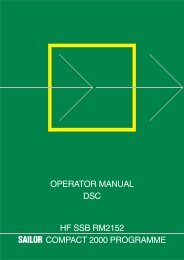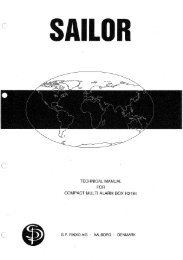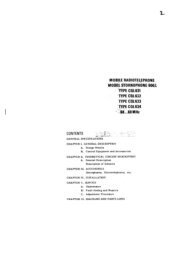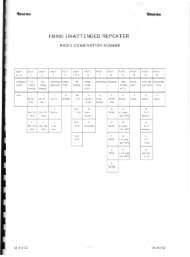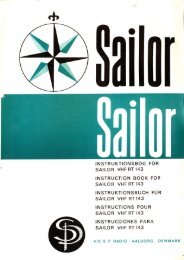TECHNICAL MANUAL FOR COMPACT VHF DSC RM2042
TECHNICAL MANUAL FOR COMPACT VHF DSC RM2042
TECHNICAL MANUAL FOR COMPACT VHF DSC RM2042
Create successful ePaper yourself
Turn your PDF publications into a flip-book with our unique Google optimized e-Paper software.
5 CIRCUIT DESCRIPTION AND SCHEMATIC DIAGRAMS <strong>RM2042</strong>5.3 RECEIVER (MODULE 3) PART NO. 626943The receiver module contains a fully channel-70 receiver, FSK decoder/encoder, switches and controlelogic for automaticly change over between the build-in channel-70 receiver and the connected <strong>VHF</strong>radiotelephone.The block diagram of the build-in channel-70 receiver is shown below. This receiver is constructed inaccordance with the double super heterodyne principle, which is characterized by having two intermediatefrequencies. The input signal to the receiver, which is an FM signal, is received by means of aseparate antenna connected directly to the <strong>RM2042</strong>.ReceiverFront-end156.525 MHzFirst MixerSecond Mixer1. IF. 2. IF.15,3 MHz450 kHzQuadratureDetectorf LO1 = 141,225 MHzf LO2 = 14,85 MHz27677Channel-70 receiverRECEIVER FRONT-ENDThe receiver front-end is tuned to channel 70 (i.e. 156.525 MHz) and consist of the low noise dual gateMOSFET transistor Q1 surrounded by two double tuned bandpass filters with high quality factor Q.From the antenna the signal is led to the input bandpass filter, that consist of two resonance circuits, whichis critically coupled to each other by the series connection of the two capacitors C2 and C3.The two resonance circuits is tuned by the two adjustable coils L1 and L2 and has a total bandwidth ofabout 10 MHz. The two diodes D1 and D2 is located in the second section of the input bandpass filter toprotect the RF-amplifier from damage by high voltages.The configuration of the intermediate filter at the output of the RF-amplifier is identical to the inputbandpass filter. The intermediate filter is tuned by the two adjustable coils L3 and L4 and has a bandwidthof about 4 MHz.The front-end selectivity gives the necessary attenuation of unwanted out of band signals, which as anexampel could be a signal at the image frequency (i.e. f IM= 125.925 MHz).FIRST MIXERThe first mixer is an balanced active J-FET mixer with good large signal properties and low noise factor.The signal from the receiver front-end is led through the unbalanced to balanced transformer TR1 to thegates of the two J-FET’s Q2 and Q3. These J-FET’s are switched by injecting the 1st. LO signal to thesources and a multiplum of the RF- and LO-signal is then generated. This new signal is led to the outputtransformer TR2, where the wanted signal at the first intermediate frequency at 15.3 MHz is selected bythe tuned circuit consisting of TR2 and C24.FIRST LOCAL OSCILLATORThe first local oscillator is generating the injection signal at 141.225 MHz to the first mixer. The oscillatoris crystal controlled and is oscillating directly at the wanted LO frequency.9716PAGE 5-13





